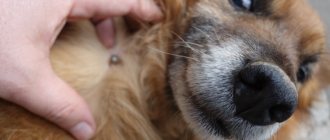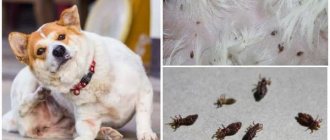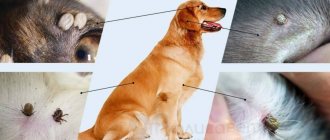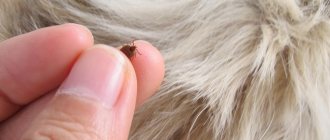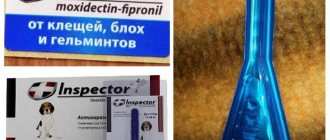Piroplasmosis in dogs is a deadly disease caused by Babesia, which is transmitted by Ixodid ticks. Microbes enter the blood and destroy red blood cells, causing a deficiency of oxygen in the blood, which is actively involved in oxidative processes. Their waste products poison the body, causing vomiting and diarrhea. If the owner does not treat babesiosis in the dog, there is a high probability that the pet will die.
What is piroplasmosis in dogs
Babesia are the simplest of the genus of protists. They are able to mutate and adapt well, so in nature there are more than 100 forms of these parasites, each of which is dangerous only for a certain type of mammal.
A negative reaction in dogs is caused by protozoa, which belong to the species Babesia canis:
- Babesia canis canis is the largest variety, causes an acute reaction, and is severe.
- Babesia canis vogeli – the disease has a favorable prognosis.
- Babesia canis rossi – causes the most deaths.
- Babesia gibsoni is one of the smallest forms of Babesia.
The mechanism of development of the disease piroplasmosis in dogs
When a tick attaches itself to a pet, Babesia is activated. They migrate to the salivary glands of the tick and enter the bloodstream as part of the saliva. Babesia penetrate red blood cells and begin to reproduce asexually. When there are too many of them, they destroy red blood cells to become uninfected red cells.
The immune system reacts to this with an acute reaction:
- The amount of fibrinogen and C-reactive protein increases.
- The level of platelets and leukocytes decreases.
- Blood pressure decreases.
- Antibodies are formed that can destroy not only Babesia, but also healthy red blood cells.
Despite the active reaction, the immune system cannot completely eliminate piroplasmosis after a tick bite in a dog. Red blood cells are a reservoir of parasites, and when destroyed, they constantly splash a new portion into the blood.
Types of ticks and their level of danger
A tick is an arthropod arachnid that leads a parasitic lifestyle. It is often mistakenly classified as an insect. It's quite easy to remember their differences. Arachnids have an additional, fourth pair of limbs.
The arthropod occurs in 4 forms: egg, larva, nymph and adult. Only eggs are not adapted to self-feeding, so all other forms are dangerous for warm-blooded individuals and humans.
All known species are divided into 3 large groups:
- External
. They attach themselves to the outside of the body and are among the most dangerous. This group includes ixodic and encephalitic individuals that carry piroplasmosis, borreliosis and encephalitis.
- Subcutaneous
. They parasitize under the skin, penetrating into it from the external environment. Infection occurs locally or generalized, that is, it covers a certain area or the entire body of the animal.
- Intradermal
. They live inside the body in a dormant form from the moment of birth. They pose a danger when certain factors occur.
Ixodid ticks are held on to the fur by tiny spines covering 4 pairs of limbs. Their oval body is covered with a dark chitinous shell. While feeding, they cut the skin with teeth on their proboscis and inject an anesthetic. The body of the parasite, filled with blood, increases 3 times.
Subcutaneous include the white or yellowish-white sarcoptes scabiei, which causes sarcoptic mange, and the dirty gray notoedres, which causes notoedrosis (scabies). The size of these bloodsuckers does not exceed 0.45 mm.
The smallest representative is the subcutaneous demodex canis, which is light gray in color. The length of its cigar-shaped body is 0.2-0.3 mm. The parasite lives in the sebaceous glands and hair follicles.
How does babesiosis become infected?
Ticks can be called both the main and intermediate hosts of protozoa. They become infected from rats and other small rodents that are not susceptible to Babesia.
In the body of ticks, Babesia reproduce both sexually and asexually. They pass through the stage from larvae to imago, and are transmitted through eggs to the next generation of arthropods. Ticks, to which the infection is inherited, become completely infected. In particular, Babesia enter the salivary glands.
When a tick bites through an animal's skin, the protozoa enter the bloodstream with saliva. They immediately invade red blood cells and begin to multiply, destroying red cells. When red blood cells rupture, new parasites emerge and infect other blood cells. Therefore, ticks are not the only route of infection.
Infection can also occur:
- when receiving blood transfusion from a sick animal;
- from bitch to litter;
- with bites (for example, during a fight).
How to remove a tick from a dog's body?
In order to remove a tick from a dog’s body, you must first drop vegetable oil, gasoline, alcohol onto the bite site and leave it on the skin for several minutes. After these procedures, the tick will fall off on its own or weaken its grip and we will remove it using tweezers. It is best to grab the tick with tweezers in the head area and begin to twist it so that the tick’s head does not remain in the dog’s body.
Removal using thread. We tie the tick with a thread on both sides and, as in the previous case, begin to carefully and slowly unscrew it from the skin. After removing the tick, in order to prevent the spread of infection, the wound must be treated with a 5% iodine solution.
Removing ticks using special shampoo. To do this, you will need to buy a drug at the pet store that kills tick larvae and weakens the effect of the tick itself. Any remaining ticks after washing will need to be removed manually. However, the dog owner should in no way think that after removing the tick from the dog’s body, the danger of its infection with one or another infectious disease has completely disappeared. Infectious diseases, depending on the type of infection, can occur in a dog after several days or months.
Acute form of piroplasmosis in dogs: symptoms and signs
The incubation period of piroplasmosis in dogs usually lasts from 5 to 7 days, less often it extends to 3 weeks. If you miss the signs of babesiosis in dogs after a tick bite, the pet will die in a few days due to breathing problems, anemia, and kidney failure.
Signs of piroplasmosis in dogs after a tick bite
With babesiosis, urine becomes the color of beer. A sick pet refuses to eat, apathy and increased fatigue appear. The temperature during dog piroplasmosis first rises to 40-41°C. Then it can drop to 37°C, before dying it can drop to 36-35°C.
Other symptoms of babesiosis in dogs at the acute stage:
- increased heart rate and breathing;
- vomiting blood;
- yellowing of the mucous membranes, sclera of the eyes;
- greenish or yellow stool.
Symptoms of liver and spleen damage
2-3 days after infection, anemia develops due to the breakdown of red blood cells. The urine becomes dark because it contains bilirubin, a toxic pigment produced by the breakdown of red blood cells in the spleen. Usually it is processed by the liver and sent into bile, in which it helps digest food. It then ends up in the stool and comes out, giving it a dark color.
With babesiosis, the liver cannot cope with the task, so bilirubin goes into the blood and poisons the body. The kidneys partially filter it out and remove it from the body in urine, which is colored by bilirubin the color of beer.
Thus, the liver and spleen are greatly affected by piroplasmosis. Ascites may develop - fluid retention in the abdominal cavity, which leads to the appearance of a belly.
Babesiosis in dogs: symptoms of platelet damage
Due to a deficiency of platelets, the blood vessels of the mucous membranes burst, and blood clotting is impaired. This leads to stomatitis, gastritis, and muscle inflammation.
Babesiosis in a dog: signs of brain damage
The disease often causes complications on the central nervous system. The following symptoms are possible:
- epileptic seizures;
- movement disorders;
- complete or partial paralysis – the dog has difficulty moving and cannot stand on its hind legs.
Complications of the disease
Treatment of demodicosis on the face should be carried out exclusively with the assistance of a doctor. Self-medication or ignoring this problem may not only not bring the desired result, but also worsen the course of the pathology. Skin scratching and regular trauma to the skin (due to severe itching and the patient’s desire to remove the rash mechanically) lead to disruption of the barrier function. As a result, the risk of developing a pustular infection significantly increases, which can be diffuse and affect large areas of the body.
In addition, this disease (especially demodicosis on the face in women) leads to psychological problems. As a result of the appearance of visible defects, the patient becomes withdrawn, begins to feel embarrassed about his appearance and stops leading a full-fledged lifestyle (closes himself off from the outside world, stops communicating with people, prefers to be alone). As this problem worsens, the developed complexes can develop into psychoses, neuroses and prolonged depression.
A large number of people with this diagnosis have concomitant pathologies (gastrointestinal tract, endocrine glands, etc.) and chronic infectious foci. Demodicosis damage to the body contributes to the aggravation of these conditions and, accordingly, deterioration of well-being.
Diagnosis of piroplasmosis (babesiosis) in dogs
The clinical symptoms of babesiosis can be confused with other dangerous diseases. Babesiosis often occurs simultaneously with leptospirosis and is combined with other dangerous diseases. A blood test for piroplasmosis in dogs will help to understand the nature of the disease. Based on this, the veterinarian will be able to prescribe the correct treatment regimen for babesiosis.
In the early stages of infection, pathogens may not be detected unless the infection has spread throughout the body. Traces of it appear in a capillary blood smear a week later. A more expensive test for babesiosis in dogs, PCR, detects traces of DNA 3-5 days after infection.
Testing for antibodies in the acute course of the disease does not make sense, since they have not yet formed in animals by this time. They can be used to determine the chronic course of the disease.
Since Babesia is not easy to detect in the blood at the initial stage, the doctor makes a diagnosis by analyzing the number of leukocytes, platelets, and young red blood cells. Before treating piroplasmosis in dogs, the doctor must exclude:
- anaplasmosis is another disease caused by ticks;
- immune hemolytic anemia;
- immune thrombocytopenia;
- urinary tract infection;
- poisoning.
Demodicosis treatment
The treatment regimen for demodicosis is a set of measures aimed at eliminating external symptoms and the cause that provoked them. The final stage of therapy is the use of preventive measures that help consolidate the therapeutic result and prevent relapse of the disease. It is important to understand that it is almost impossible to cope with this problem on your own. This problem requires qualified help and long-term drug treatment, since an infected person is dangerous to others. It is a source of infection and can therefore infect other people.
Standard therapy aimed at eliminating demodicosis infection consists of several parts:
- Diet for demodicosis. The patient will need to give up fatty, spicy and smoked foods. It is also recommended to reduce your consumption of sugar, sweets and dairy products. The diet should consist of low-fat fish, vegetables and fruits;
- Local treatment. For this purpose, sulfur ointment is used for demodicosis, creams and sprays that have antibacterial and antiparasitic properties;
- Systemic treatment. It is aimed at normalizing sebum production and eliminating existing imbalances (hormonal or metabolic). To do this, it is possible to involve specialized specialists, prescribe antibiotics in tablet or injection form;
- Symptomatic treatment. It is aimed at improving the patient’s well-being, eliminating active symptoms (inflammation, itching, soreness and redness). For this purpose, a special anti-demodetic mange may be prescribed;
- Physiotherapy. To improve the condition of the skin, electrophoresis, laser therapy and ozone therapy are prescribed.
Since it is practically impossible to cure demodicosis quickly but effectively, the average duration of the treatment course ranges from one to several months. The duration depends on the severity of the pathology and the individual characteristics of the body (in some cases, treatment may take a year or more). The main criterion for cure is a repeat tape test with a negative result.
Treatment of piroplasmosis in dogs
If a dog becomes ill with babesiosis, it should be taken to the doctor immediately. Babesiosis must be treated in a clinic - the pet may need IVs or blood transfusions at any time. Treatment of piroplasmosis at home is allowed if it is not possible to leave the pet in the hospital or if it is recovering. In this case, the doctor must personally monitor the animal and always be in touch.
To treat babesiosis in dogs, the doctor prescribes the following medications:
- Antiprotozoal drugs – Forticarb, Imochem-120. These drugs for piroplasmosis for dogs can be used not only for treatment, but also for prevention (only after consulting a doctor).
- Anti-inflammatory drugs (dexamethasone) - when treating babesiosis in dogs, drugs are prescribed to relieve swelling and reduce abnormal immune responses.
- Antibiotics (azithromycin, tetracycline).
- Giskan-5 - to normalize the functioning of the immune system, improve its resistance to disease. This drug can also be used if there is a suspicion that the pet has been in contact with an infected animal.
- Hepatoprotectors – strengthen the liver during illness and prevent complications.
- Heart medications – protect the heart.
- Blood transfusion - in severe cases.
Preventing tick bites
To prevent tick bites, your dog must be treated with special medications. Their choice on the market is currently quite large - from drops on the withers to tablets. The main factors that need to be taken into account are that the drugs must be intended for dogs (human aerosols protect animals less well, and in some cases can cause poisoning), the dosage and frequency of use recommended by the manufacturer must be followed.
The drugs are not 100% protection - in case of an accidental tick bite, infection with piroplasmosis is possible even in a treated dog, but they significantly reduce the risk of this disease. The drug fluralaner is also now on the market, which provides a higher level of protection, preventing the risk of even an accidental bite.
(c) Veterinary center for the treatment and rehabilitation of animals “Zoostatus”. Varshavskoe highway, 125 building 1. tel. 8 (499) 372-27-37
Possible consequences and complications of piroplasmosis in dogs
Babesiosis severely damages the liver, so the most common complication after treatment is chronic hepatitis. Provide your pet with high-quality nutrition that will not overload the liver.
Other complications after piroplasmosis in dogs:
- anemia;
- renal failure;
- problems with the heart, blood vessels (heart failure);
- cerebral ischemia;
- spleen diseases;
- pancreatitis - inflammation of the pancreas;
- partial paralysis of the hind limbs;
- nervousness, seizures and other problems related to the nervous system.
Causes of demodicosis
As mentioned above, the main reason for the development of this disease is the active reproduction of the iron mite. There are several possible reasons that can lead to increased activity of these opportunistic microorganisms. These are internal and external factors. The first category includes:
- A significant drop in immune defense and exhaustion of the body caused by poor nutrition, autoimmune pathologies, previous diseases, constant stress, etc.;
- Viral and microbial diseases that occur in chronic forms (hepatitis, tuberculosis, etc.);
- Helminthiases. The vital activity of helminths contributes to the weakening of the immune system;
- Malignant neoplasms. With many types of oncology, the body becomes exhausted, making it more difficult for it to cope with infections;
- Damage to the gastrointestinal tract. There is a proven relationship between the bacterium Helicobacter pylori and demodicosis;
- Other skin diseases. These are seborrheic dermatitis, rosacea, acne, etc. In the presence of inflammatory processes or integrity disorders on the skin, the risk of pathogenic activation of opportunistic flora increases significantly;
- Hormonal imbalance associated with illness or natural condition (for example, pregnancy or breastfeeding).
Skin demodicosis can also develop as a result of exposure to unfavorable external factors. As a rule, they are combined with internal ones, but in some cases (for example, choosing the wrong skincare products) they can be the main etiology. Among them:
- Temperature effect. This parasite multiplies especially actively in warm conditions;
- Unhealthy Lifestyle. This includes poor nutrition, frequent stress and bad habits;
- Use of low-quality cosmetics for care. This is especially true for cosmetics that do not have quality certificates and do not meet legal requirements;
- Poor environmental conditions. High levels of environmental pollution lead to a weakening of the barrier function of the skin.
What to feed your pet with piroplasmosis
If your pet doesn't want to eat, don't force food in. To maintain strength, give your pet food often - take liquid (you can use lean broth) into a large syringe without a needle and squeeze it into the mouth. Don't give me milk!
The diet should be aimed at increasing hemoglobin, immunity, and vitality. If you still have an appetite, give pureed lean meat (turkey, beef, lamb), add a little vegetable oil. Check with your veterinarian whether you can give porridge (rice, buckwheat, wheat) with meat. If yes, cook the cereal and make a puree. If the dog refuses porridge, do not give it.
As an option, you can buy ready-made dietary food intended for animals with diseased kidneys and liver. The dry must be soaked until it becomes a paste, the canned food must be mixed with warm water. The food should not be cold.
Demodicosis in children
- In childhood, this pathology rarely develops (due to the low activity of the sebaceous glands), but its course is much more complicated than in adults. As a rule, in children this disease is chronic, and relapses occur in the off-season. The main signs of the problem are:
- Swelling of the eyelids;
- Loss of eyelashes and hair;
- Severe eye fatigue;
- The appearance of spots on the skin;
- Itching, worse at night and on contact with water;
- Decreased appetite, moody behavior, decreased physical activity;
- Pain in the eyes.
The treatment regimen for democosis of the face and other parts of the body in children is practically the same as therapy for adults. It also includes diet, medication and rehabilitation aimed at healing the tissue and preventing scarring. The fundamental difference in the treatment method is only the dosage of medications, which will be lower in childhood.
What to feed a dog after piroplasmosis
After an illness, the dog is exhausted and weakened, so food should be given little by little. The diet should be developed by a veterinarian taking into account the pet’s condition. The basic feeding rules are:
- Portions should be small.
- Feeding is fractional - if before you fed your pet 2 times a day, now you need 4-5 times.
- Food should be warm, liquid, pureed. Cereals and boiled vegetables can be given in the form of puree.
- Grind lean meat (beef, lamb, turkey).
- Liver – contains iron (in limited quantities).
- Fish can be given only boiled, low-fat. If the disease causes complications on the kidneys, it is better to refuse it.
- If the dog is accustomed to industrial food, give the product for a diseased liver and kidneys.
- When your pet eats natural food, exclude fatty, carbohydrate foods, and chicken.
- Iron supplements, vitamins, and minerals should be added to food (the doctor will tell you the name).
Read also
Subcutaneous mites in dogs: treating demodicosis
What disease can lead to serious consequences for a dog’s body or even death? The most common and dangerous disease is demodicosis.
Ear mites in dogs: Symptoms and treatment of otodectosis
Otodectosis or ear scabies is a chronic invasive disease caused by microscopic itch mites.
Dog castration: 5 reasons for and against
Castration is one of the most responsible ways to care for a dog. With the help of the procedure you will reduce aggression and anxiety associated with testosterone
What diseases are most common in dogs? Symptoms and signs
A dog cannot complain; it is necessary to determine that it is sick by the appearance and behavior of the pet
Fleas on a dog. How to withdraw?
Fleas can cause a lot of discomfort and suffering to your animals, but they must be removed very carefully
Prevention of piroplasmosis in dogs
Regularly treat your pet with anti-tick medications. If you live outside the city and often go into the forest, give preference to tablets. Even if a tick grabs a dog, it will die before it can drool into the blood.
Ticks attack pets in the warm season, especially in early spring, but there are cases when parasites were found in winter, at -12°C. Therefore, after every walk, inspect your dog for ticks.
If you find a tick on your pet, carefully remove it. For prevention, give an injection against piroplasmosis for dogs with the following drugs:
- Forticarb - the effect lasts for a month, it is recommended to inject if the possibility of infection is suspected. You can use the medicine in the treatment of piroplasmosis for dogs.
- “Nobivak-Piro” - vaccination is done in winter, when the risk of infection is minimal. Vaccination against piroplasmosis for dogs does not completely protect against the disease, but significantly alleviates its course. Nobivak-Piro is a prophylactic agent and cannot be used for treatment.
Remember that the infection is transmitted during fights. Keep an eye on your pet, do not allow it to fight or play with other people's dogs.
At the first symptoms of piroplasmosis (lethargy, apathy, vomiting, dark urine), take your pet to the veterinarian. Remember - timely treatment will save the life of your four-legged friend.
Prevention recommendations
Infection cannot be ruled out, but the risk can always be reduced. Important for your pet's health
:
- Don't neglect vaccination. Passive immunity lasts for six months. Even if infected, a vaccinated individual will tolerate the disease more easily.
- Limit communication with unfamiliar four-legged animals. Most often, stray dogs and wild animals become carriers. And playing with a fluffy squirrel is fraught not only with invasion, but also with rabies.
- Carefully inspect hard-to-reach places on your body after each walk. The speed at which the first symptoms appear varies from person to person. If no signs are found, then repeat the skin examination after a couple of hours.
- Control your diet. A proper and balanced diet is the key to a strong immune system.
- Contact a veterinary clinic for help with any questions or suspicions. It is better to make mistakes several times than to lose your beloved dog due to carelessness.
- Use anti-tick agents during periods of increased parasite activity: from April to October. If the dog has long hair or profuse sweating, which requires frequent washing, increase the recommended dosage of medications.
- Avoid mating if infestations are detected. Feel free to ask for information from the second owner.
- Sterilize after infection with subcutaneous parasites. Not only future offspring can suffer, but also the bitch herself. Relapse of the disease occurs against the background of any hormonal changes.
Antiparasitic agents include vaccines, collars, sprays and drops. Each of them has its own advantages and disadvantages.
Vaccine
Giving your pet a vaccine will reduce the likelihood of infection. The most popular include “Nobivak Pro” and “Pirodog”. These vaccines protect against piroplasmosis. Only healthy animals are allowed to be vaccinated. Vaccination after infection is pointless.
To consolidate the result, a second vaccination is given 1 month after the first vaccination. All subsequent ones are done once every six months independently or in a veterinary clinic.
Collars
Collars last for more than six months, but often cause local allergic reactions. If your pet's hair falls out, you will have to abandon the collar in favor of drops or sprays.
“ Due to the ingredients included, the collars are not suitable for nursing or pregnant women, puppies under 2 months of age, or animals with chronic illnesses.
The smell emitted by the product repels insects and remains on the body for some time even after removal. According to the method of exposure, they are chemical, biological and ultrasonic. The first two are repelled by the smell of chemicals or essential oils, and the last one is repelled by ultrasound, which is detected only by arachnids. An ultrasonic collar is more expensive than its analogues, but is considered safer.
Question answer:
Piroplasmosis in dogs: what to do?
At the first symptoms, consult a doctor and donate blood to be tested for piroplasmosis in your dog. If the dog is sick, adhere to the prescribed treatment regimen.
Can a pet cure babesiosis on its own?
No, if the pet is not provided with qualified medical care, the dog may die.
How does an animal become infected with babesiosis?
A dog becomes infected with piroplasmosis after a tick bite. The infection is also transmitted through blood transfusion, after a fight with infected dogs, from mother to puppies.
How long does it take for piroplasmosis to appear in dogs?
Signs of piroplasmosis in dogs after a tick bite may appear the very next day, but on average the incubation period lasts 5-7 days. Sometimes it lasts up to 3 weeks.
Will vaccination prevent piroplasmosis?
Vaccination against piroplasmosis protects the dog in 75% of cases. But vaccination is necessary: if the pet gets sick, the disease will be easier.
Important tips if your dog is bitten by a tick
- Even if you left part of a tick in the wound, do not panic. He can no longer inject saliva. But inflammation may begin, so it is better to contact a veterinarian so that he can remove the remains of the parasite.
- A tick can sit on a dog’s fur for 2–3 hours before it attaches itself to the skin. This is why inspections after every walk are so important.
- Even if the tick you tested turned out to be infectious, this does not mean that the dog will definitely get sick. In some animals, the immune system copes with infection on its own.
- Ticks are talked about a lot in the summer, but they become active from the end of March. And they don’t disappear until the first frost. During this period, treatment should be constant: write down the dates when the tablets were given, the collar was put on for the first time, check the timing of all medications.
- Some diseases are dangerous for both dogs and people. For example, borreliosis. Therefore, treating your pet is important for the health of your entire family.
